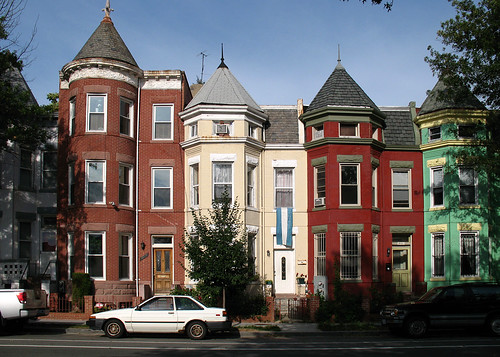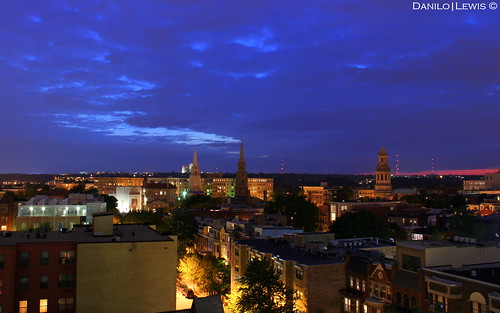
’11th Street NW Rowhouses’
courtesy of ‘Mr. T in DC’
Washington DC is a city of neighborhoods, many of which the tourists who visit our fair city never really experience. But the unique neighborhoods of the District are what make it special– the beautiful rowhouses in Capitol Hill, the commercial centers in Penn Quarter and Georgetown, the arts districts in Logan Circle and U Street– these are the coolest parts of the city. But what do you really know about DC’s neighborhoods? How many neighborhoods do you think the District has? Can you locate Kent, Swampoodle, or Twining on a map? And how do these neighborhoods compare? Read on to learn more about the District’s unique neighborhoods.

‘Colors!’
courtesy of ‘kimberlyfaye’
There are some DC neighborhoods that steal the spotlight– even tourists know about Dupont Circle and Adams Morgan, U Street has become a major tourist destination, and Anacostia is known throughout the country. But there are so many other, smaller neighborhoods in the District that you might never have heard of. Try to take a guess at how many neighborhoods make up the District. Thirty? Fifty? Not even close. The official neighborhood list of DC includes 131 named neighborhoods, and this map includes 127 distinct neighborhoods. My Ork poster of the city includes at least 100, though I lost count several times (it’s tricky, ok? There’s sideways writing!).
Many of the District’s neighborhoods are named for their physical geography: Truxton Circle, Columbia Heights, Washington Highlands, etc. Some others are named for people, like Carver Langston or Adams Morgan. A couple others, like NoMA and Tivoli North, were invented. And then some were left with interesting names, like Swampoodle.

‘139/365’
courtesy of ‘Danilo.Lewis|Fotography’
So what are these neighborhoods like? Well, the best data on neighborhood comparisons is done at the Neighborhood Cluster level, which aggregates data from about 3 neighborhoods. So while the boundaries of the clusters might not exactly match neighborhood lines, they give us a pretty good idea about a neighborhood’s characteristics (at least back during the 2000 Census, which is where these numbers come from).
Neighborhood with Highest Percentage of Foreign-Born Residents: Columbia Heights/Mt. Pleasant/Pleasant Plains/Park View. A full third of residents in these neighborhoods were born outside of the US. Definitely the place to head for authentic ethnic cuisine!
Neighborhood with Lowest Percentage of Foreign-Born Residents: Douglass/Shipley Terrace. Only 0.5% of residents in these neighborhoods, located east of the river along the border with Maryland, were born in a foreign country.
Neighborhood with Highest Percentage of Car-Owning Residents: Spring Valley/Palisades/Wesley Heights/Foxhall Crescent/Foxhall Village/Georgetown Reservoir. Over 91% of households in these neighborhoods owned cars, which makes sense in this spread out and suburban part of the city.
Neighborhood with Lowest Percentage of Car-Owning Residents: Near Southeast/Navy Yard and Downtown/Penn Quarter. In these neighborhoods, only 30% of households own cars, which also makes sense in these compact, walkable areas with plenty of transit service. (Car ownership is also correlated with household income, and during the 2000 Census Near Southeast/Navy Yard had the highest percentage of residents living in poverty at 50%).
Neighborhood with Highest Percentage of Kids Under 18: Sheridan/Barry Farm/Buena Vista. These neighborhoods,located east of the river, are the city’s youngest. Over 37% of residents in these neighborhoods are 18 and under.
Neighborhood with the Lowest Percentage of Kids Under 18: West End/Foggy Bottom/GWU. This area is full of people just over 18 who are not yet having kids, which explains why only 1.2% of the population is 18 and under.
So DC’s neighborhoods run the gamut– there are neighborhoods where 1/3 of residents weren’t born in America and neighborhoods where only half of a percent weren’t. There are neighborhoods where almost everyone owns a car and neighborhoods where no one needs one. Young and old, rich and poor, DC’s neighborhoods can’t all be grouped together. The diversity of our neighborhoods is what makes DC special– there are over 100 neighborhoods out there, all with unique histories and residents.
It’s easy to shake our heads at tourists who only visit the Mall and think they’ve seen DC, but even us residents don’t see a lot of the city outside our own neighborhoods. So while you’re here, take the time to explore some of the 100+ neighborhoods in the District.
carver langston was named after two people and are actually 2 neighborhoods.
and its more accurate to say that adams morgan was named after 2 schools than to say it was named after a person.
what is an “invented name”?
I’d be a little leery of mentioning those 2000 census statistics for Near Southeast as having any bearing on the neighborhood’s current profile–that was when the vast majority of its residents lived in public housing, and not shiny new townhouses or 12-story buildings as is now the case. Though I imagine the car ownership level is probably still lower than much of the rest of the area.
@dfesd My point about the names was that they all took elements from people’s names (though in the case of Adams Morgan, from schools named after people), rather than geographic features. And by invented name, I meant that someone just thought them up and branded the neighborhood that way. See the Tivoli North debate or the general hatred of the name NoMA.
i think most people who live in the area would consider carver-langston a single neighborhood now, though you’d be right to say that the rowhouse part and the garden apartment part of the neighborhood are quite different in feel.
I am surprised Eastern Market is not considered a neighborhood. Also, on the neighborhood map, it appears Lincoln Park does not include Lincoln park? Is that right? I know at least anecdotally when I hear Lincoln Park, it is usually in reference to the area around the park itself.
Honestly, I live in DC and I could care less about acknowledging all 131 neighborhoods. If a neighborhood doesn’t have a commercial node/corridor it isn’t a destination. And if it isn’t a destination why would I care about it’s name rather than lump it in with the nearest destination?
I wouldn’t say there’s such a neighborhood as “Spring Valley/Palisades/Wesley Heights/Foxhall Crescent/Foxhall Village/Georgetown Reservoir”. They’re all pretty distinct. Not to mention that Georgetown has a car ownership of about 80%.
Pingback: FoBo in the News -FoBoBlo